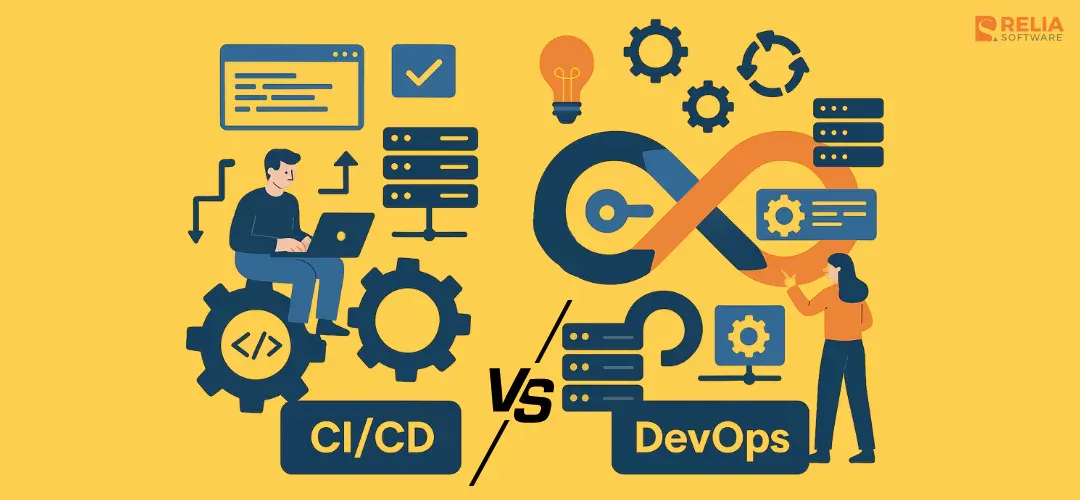In the fast-paced world of software development, working together and being efficient are very important. Both CI/CD and DevOps have become powerful ways to speed up delivery, improve software quality, and streamline the development process.
Although they have the same objectives, there are still differences in the way they work. Some people still find it hard to figure out what the main differences are in CI/CD vs. DevOps. This article shows you some main differences between CI/CD and DevOps including what each method involves, and how they can help your software development team.
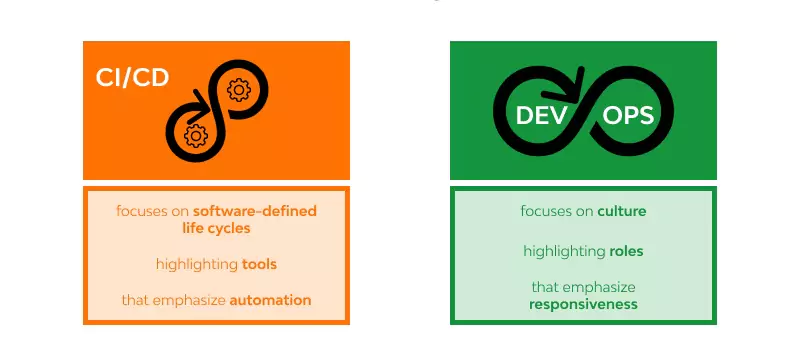
CI/CD vs. DevOps: Key Differences
Purpose
CD/CI: Quicker Releases
The main goal of CI/CD is to automate key steps in the software development process. In these steps, changes to the code get combined (integration), bugs are detected (testing), and users receive the updates (release). CI/CD makes sure that updates happen often and consistently by handling these tasks; as well as finds bugs early and speeds up releases.
CI/CD works as an efficient machine to ensure a smooth development process. Developers add code and provide updates; while tests run automatically to find problems.
DevOps: Improving Teamwork
DevOps goes one step further. It's not just about automating things; it makes everyone need to work together. With DevOps, the development and management teams are encouraged to talk to each other and work together. This change in culture makes the whole process of delivering software easier, from planning what to build to making sure it works well after release.
DevOps removes barriers between teams, making the work run more smoothly. Imagine that developers and operations staff worked together to make sure the move from development to real-world use went smoothly. That's the power of collaboration in DevOps.
Tools and Technologies
CI/CD: Automation Tools
CI/CD is all about making important parts of the development process automatic. Some important tools making the work of coders and testers easier during the development stage are:
- Version control systems: The ability to monitor changes, collaborate, and even rewind is a feature of version control systems such as Git.
- Set up build servers: These are the workhorses that build and prepare code for release automatically. They can even start building themselves when the code changes, which saves writers a lot of time.
- Automation frameworks: These frameworks help developers construct automated tests to check for errors and improve code quality.
DevOps: A Toolkit for Efficient Delivery
Compared to automating CI/CD, DevOps uses a bigger range of tools to improve the whole delivery process. These tools do more than just development and testing; they also handle infrastructure and deploy software:
- Config management technologies: Configuration management tools make sure that everything is consistent and cut down on mistakes.
- Tools for infrastructure as code (IaC): Think of infrastructure as code as a plan. IaC tools let developers describe infrastructure in code, which makes it possible for environments to be set up and deployed automatically.
- Containerization systems: The containers neatly bundle whole apps with all of their dependencies into small packages called "containers." This makes it very easy to launch and grow in different settings.
>> Read more:
- Top 9 Best DevOps Deployment Tools for Businesses
- Top 22 Best DevOps Automation Tools For Businesses
Roles and Responsibilities
CI/CD: Developer and Tester Empowerment
CI/CD mostly helps developers and testers by automating tests that they do repetitively during the development lifecycle. This gives them more time to work on more difficult jobs and new ideas.
- Developers: CI/CD automates jobs like building and testing code so that developers can focus on writing simple, effective code and adding new features. Additionally, automatic testing lets them get feedback on their work more quickly, which leads to better code.
- Testers: CI/CD automates testing, letting testers develop more thorough test suites and focus on exploratory testing. Instead of repeating tests, they can analyze findings and identify key important flaws.
DevOps: Teamwork Is Essential
Teamwork is an important part of DevOps. Everyone works together to make sure that great software is delivered faster. This is what each team does to help:
- Development: Write clean, tested code is a big part of what developers do in DevOps. They also work closely with operations to understand what equipment is needed and ensure deployments go smoothly.
- Operations: Operations teams manage software infrastructure. In DevOps, they work together with engineers to set up and configure infrastructure automatically.
- Security: Security shields software development. In DevOps, security teams ensure all of the best practices are used.
- Other Groups: DevOps may also include business analysts, product managers, and UX designers, but it depends on the project. Collaboration between these teams makes software creation more complete.
>> Read more: What is the DevOps Engineer Salary in Vietnam?
Implementation
CI/CD: Easy Automation
In general, CI/CD is easier to set up than DevOps. Because it focuses on certain tools and automates jobs that are already part of the development lifecycle.
- Focus on tools and automation: CI/CD is mostly about putting together certain tools, like continuous testing frameworks, developing tools, and version control systems. These tools can be used by current development teams without creating too many problems.
- Start small and grow: CI/CD implementation can be gradual. Teams can slowly start using CI/CD by automating a few important jobs. And you can be proficient at a later stage. This gives testers and coders time to get used to the new tools before everything is automated.
DevOps: Collaboration Matters, But Investment Required
Compared to CI/CD, implementing DevOps needs a more all-around approach. It's not just about tools; it's also about how groups work together.
- Changes in Culture: DevOps needs a shift in how people think, which pushes teams to break down walls and work together across departments like QA, operations, and development. To help everyone talk to each other and work together better, this could include training and classes.
- Organizational Changes: Putting DevOps into practice may require breaking departments into separate units and reorganizing teams to collaborate more closely. This might be a bigger change than just putting CI/CD tools together.
>> Read more: 7 Ways DevOps Speeds Up the Digital Transformation
Learning Curve
CI/CD: Easy Automation for Beginners
Most people agree that CI/CD is easier to learn for both coders and testers of all levels, even beginners. This is why:
- Accessible Tools: Version control systems and testing frameworks are used in CI/CD. These tools are easy to learn and use with clear directions.
- Own Your Learning: You aren't required to proceed immediately. You can slowly start using CI/CD, which lets you learn new tools and ways of doing things one step at a time. Furthermore, there are numerous online resources and tutorials available to help you learn CI/CD concepts and tools. You can learn these to get started.
DevOps: More Collaboration Skills
Focusing on development, management, and communication, DevOps needs a wider range of skills for developers.
- Learning with other teams: No matter what part you play in DevOps, everyone needs to know how their work fits in with the work of other teams.
- Communication is important: With DevOps, everyone has to work together without any problems. It might take more time and practice to get good collaboration because you have to know how to communicate and work together effectively.
>> Read more: Detailed Roadmap To Become A Full-Stack Developer
Benefits
CI/CD Benefits
CI/CD brings several perks to the software development party:
- Faster Releases: CI/CD automates tasks, speeding up the delivery of updates to users.
- Catching Bugs Early: CI/CD is like a bug-hunting superhero. It automatically tests code throughout development, finding and fixing issues before they cause problems.
- Less Busywork, More Creativity: CI/CD automates repetitive tasks, freeing up developers and testers for more creative work. They can ditch the manual stuff and focus on building awesome software.
DevOps Benefits
DevOps goes beyond automation, creating a dream team environment for development:
- Adapting to Change Faster: DevOps is all about being flexible. It allows teams to adjust their approach quickly based on new needs and user feedback.
- Communication Champions: DevOps breaks down walls between different teams (development, operations, etc.) This fosters better communication and collaboration, making everyone work together seamlessly.
- Strong and Scalable Foundations: DevOps uses Infrastructure as Code (IaC) to ensure your infrastructure is reliable and consistent. IaC also allows your infrastructure to grow automatically as your project and user base do.
When To Choose CI/CD Pipeline?
While CI/CD pipelines are very helpful for software development, they might not be right for every job. The following are some cases in which a CI/CD process can be very helpful:
- Web Development and DevOps: CI/CD pipelines help web applications and microservices architectures automate deployments and infrastructure provisioning. This enables faster feature deployments, easier scaling, and a more flexible development workflow in a DevOps environment. Cloud deployment options such as storage and infrastructure as code (IaC) can help to streamline these processes even further.
- Game Development: CI/CD pipelines ensure continuous integration and testing of game builds across platforms in fast-paced game development. Early bug detection and fix deliver smoother performance and faster game updates. Games require engine integration, platform compatibility testing, and thorough QA processes. CI/CD automation will help with these.
- Data Science and Machine Learning: Complex data processing, model training, and deployment pipelines are common in data science and machine learning projects. Automation by CI/CD pipelines ensures reproducibility, efficient experimentation, and faster model deployment through these tasks.
- Security and Compliance: Security testing tools can be integrated into CI/CD pipelines to automate security checks throughout development. Developers can find and fix vulnerabilities early, promoting secure coding and industry compliance.
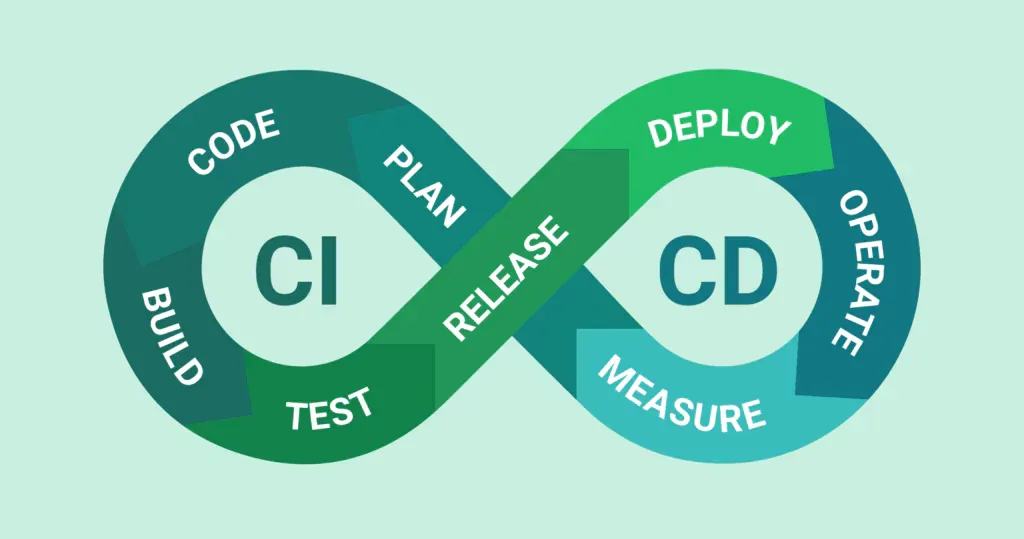
When To Choose DevOps?
DevOps is a great tool for making software, but it's not the sole method to do everything. It is some cases for DevOps to shine:
- Web Development and Operations: DevOps simplifies web application and infrastructure management in web development. Automated deployments with rollback reduce downtime and simplify scaling, improving user experience. Configuration management helps DevOps teams deploy consistently across environments. Monitoring and performance testing are also essential for proactive web application problem-solving.
- Infrastructure Management: Infrastructure as Code (IaC) is promoted by DevOps to define and provision infrastructure. This streamlines infrastructure deployment and disaster recovery. AWS and Azure provide configuration tools and version control for IaC management.
- Security and Compliance: DevOps promotes security throughout the development lifecycle. Automated security testing tools detect and fix vulnerabilities early. Threat modeling and static code analysis boost code security. Penetration testing and regular security compliance audits are essential for maintaining a secure development environment.
- Continuous Delivery and Feedback: DevOps emphasizes continuous delivery. Teams can gather user feedback using A/B testing and user monitoring as well as iterate quickly with frequent feature and bug releases. Agile frameworks like Scrum and Kanban manage this continuous delivery workflow.
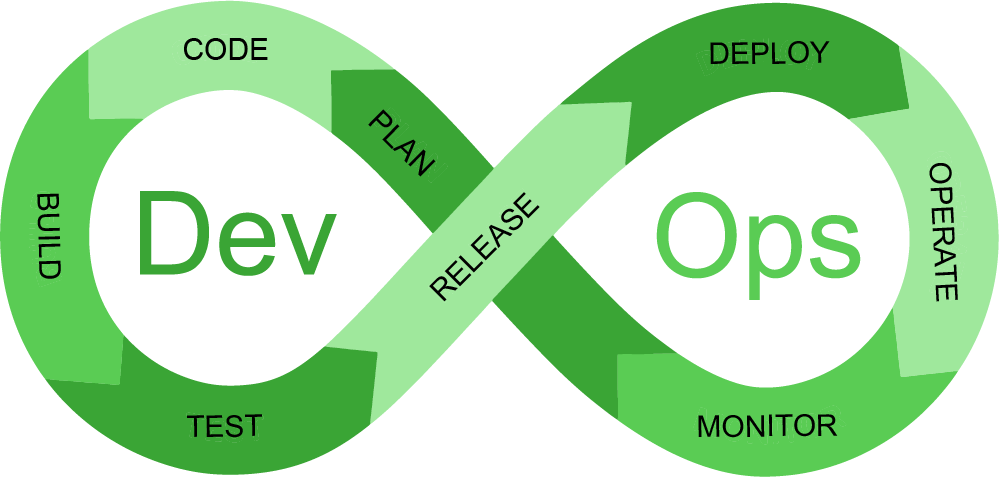
Integration and Synergy of CI/CD and DevOps
How Do CI/CD and DevOps Work Together?
In development, CI/CD is like a super-powered robot that does all the repetitive work for you. This lets coders and testers work on broader projects, which speeds up the whole process. Meanwhile, DevOps pulls together all the teams focusing on making software.
In other words, CI/CD is about the "how" of software development such as how we automate tasks. DevOps, on the other hand, is about the "why" like why we work together, and the "who" in who is involved. Furthermore, CI/CD also gives you the technology tools, and DevOps encourages a collaborative attitude that values working together and always getting better.
CI/CD is a very important part of the DevOps toolbox. It gives tools and processes you keep testing, deploying, and integrating code. By streamlining these tasks, CI/CD makes the development process run more smoothly and efficiently. This is what DevOps concerns the most. The whole software development process can be sped up when you use CI/CD and DevOps together.
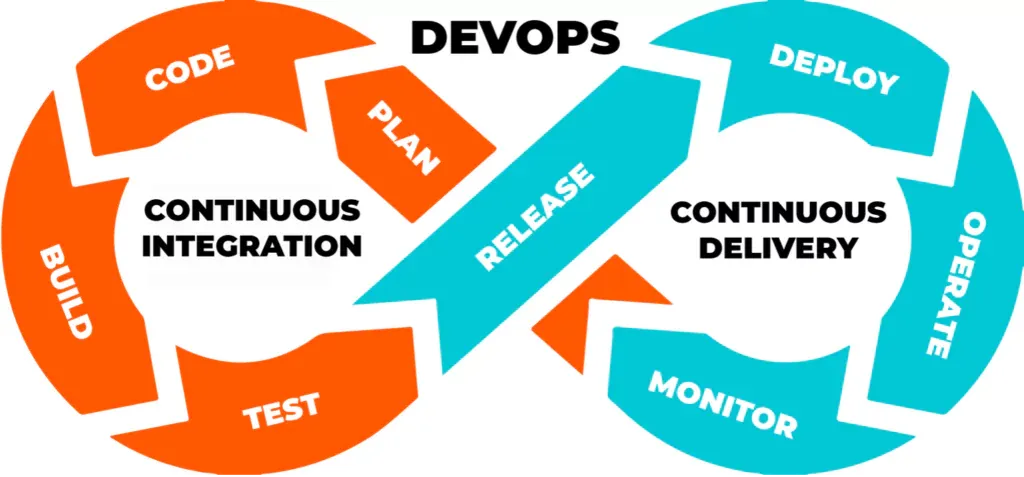
Benefits of CI/CD vs DevOps Integration
Both CI/CD and DevOps are great methodologies for software development, but they work even better when used together. Combining CI/CD and DevOps is a good idea for the following reasons:
- Supercharged Delivery Pipeline: CI/CD makes tasks automatic, and DevOps makes it easy for teams to work together. This makes the delivery process smooth and quick, so you can get software out faster and make changes more quickly.
- Building Better Software: CI/CD finds bugs early and often; while, DevOps makes this even better by making everyone responsible for quality, which makes software better all around.
- Adjusting More Quickly: CI/CD and DevOps help you quickly get comments on code changes. This lets developers make changes to their work more quickly and keep up with changing needs.
- Infrastructure Control: DevOps uses IaC to describe infrastructure through code. This, along with CI/CD automation, makes it easier and more reliable to manage and deliver infrastructure.
Best Practices for Integrating CI/CD with DevOps
Combining these two methods to work well together needs careful planning and execution. Here are some practices on how to do things right:
- Shared Goals and Values: Successful CI/CD and DevOps integration requires collaboration from cross-functional teams with operations, development, and other departments. This makes it easier for teams to communicate, collaborate, and share values and goals. Trust built makes collaboration easier.
- Enhance Communication Tools: Use the right communication tools to make conversation easier and more effective. This could include things like chat rooms, tools for managing projects, or even regular team meetings.
- Automated Tasks and Processes: Make it clear which tasks and processes in your CI/CD pipeline will be done automatically. This includes things like deploying, testing, and integrating code. Make sure the pipeline fits in with your DevOps approach as a whole.
- Track and Analyze Performance: Keep an eye on and study how well your CI/CD chain and DevOps processes are working all the time. Find ways to make things better and keep changing your method to get the most out of it.
- Maintain a Learning Culture: Encourage ongoing learning in your workforce. Get your team to learn new things and keep up with the latest CI/CD and DevOps techniques.
- Make use of Infrastructure as Code (IaC): Infrastructure as Code (IaC) should be one of the main ideas behind your DevOps method. IaC lets you set up and control infrastructure through code, which makes your CI/CD pipeline more automated and consistent.
- Testing and Auditing Security: Throughout the development process, security should be the priority. You can find and fix possible security holes early on by adding security audits and testing to your CI/CD pipeline.
Industry Use Cases Focusing on the Integration of CI/CD and DevOps
Finance:
Strong and safe software is needed for transactions and data handling in financial institutions. When CI/CD and DevOps are combined, it helps them:
- Make sure all code follows financial rules by automating regulatory compliance checks in the CI/CD process.
- Quickly put in place auditing and security changes to keep up with new threats.
- Add new features to mobile banking apps more quickly and efficiently to make the experience better for customers.
Manufacturing:
Manufacturers use complicated software systems to run their production lines and check the quality of their products. Combined CI/CD and DevOps help them:
- Test software for systems that integrate automatically in fake settings before putting it into use. This will lower risks and costs.
- Real-time data analysis can be used to keep an eye on and improve the performance of the production line.
- Quickly adapt and install software updates for automated systems and industrial robots to make them work better.
Healthcare:
Medical devices and software used to manage patient data must be safe and reliable in the healthcare business. CI/CD and DevOps help them:
- Streamline the creation and distribution of healthcare apps that follow strict HIPAA rules.
- Using continuous integration testing to find bugs early and fix them will help make sure that software for important medical tools is reliable.
- Add new features and functions to hospital information systems quickly to make patient care better.
>> Read more:
- A Detailed Breakdown For Healthcare Software Development
- Key Benefits of Healthcare Automation Systems
E-commerce:
Businesses' e-commerce site growth is typically dependent on constantly improving software for their online stores and mobile apps. CI/CD and DevOps can help:
- Test and release new product listings and features automatically to give customers a smooth experience.
- Quickly adjust to changing customer habits and trends by adding new features and fixing bugs.
- Automatically increase the size of infrastructure during busy shopping times to handle more people and transactions.
>> Read more:
- The Ultimate Guide to Ecommerce Automation Software
- Best Practices for Successful E-commerce Website Design
Challenges and Solutions for CI/CD and DevOps Integration
CI/CD and DevOps work well together, but sometimes it's hard to make them work well together. Here are some common problems you might run into and how to solve them:
Cultural Shift and Resistance to Change
Problem: Implementing CI/CD and DevOps often requires a shift in team culture, with a move towards collaboration and automation. This change might not make everyone happy.
Solution: Give your workers training courses and show everyone how CI/CD and DevOps can help them and get them involved in setting things up. Meetings, chats, and project management tools can help people get used to this approach better.
Complex Legacy Systems
Problem: Integrating CI/CD and DevOps can be more challenging with complex legacy systems that may not be easily automated or integrated with newer technologies.
Solution: Consider a phased approach, focusing on modernizing smaller parts of the legacy system first. Utilizing tools and techniques can bridge the gap between legacy systems and modern development practices.
Inadequate Monitoring and Feedback
Problem: It's hard to know what to change in your CI/CD chain and DevOps processes if you don't keep track of how things are going.
Solution: Use tools to keep an eye on speed and find places where things could be better. To make your CI/CD pipeline and DevOps routines work better, look at your data regularly.
Limited Resources and Expertise
Problem: Your team might not have the skills and resources they need to set up and run CI/CD and DevOps right now.
Solution: Spend money on training for your staff. To fill in the gaps in your knowledge, you might want to get help from experts or managed service providers (MSPs). You can also get free tools and information to help you get started.
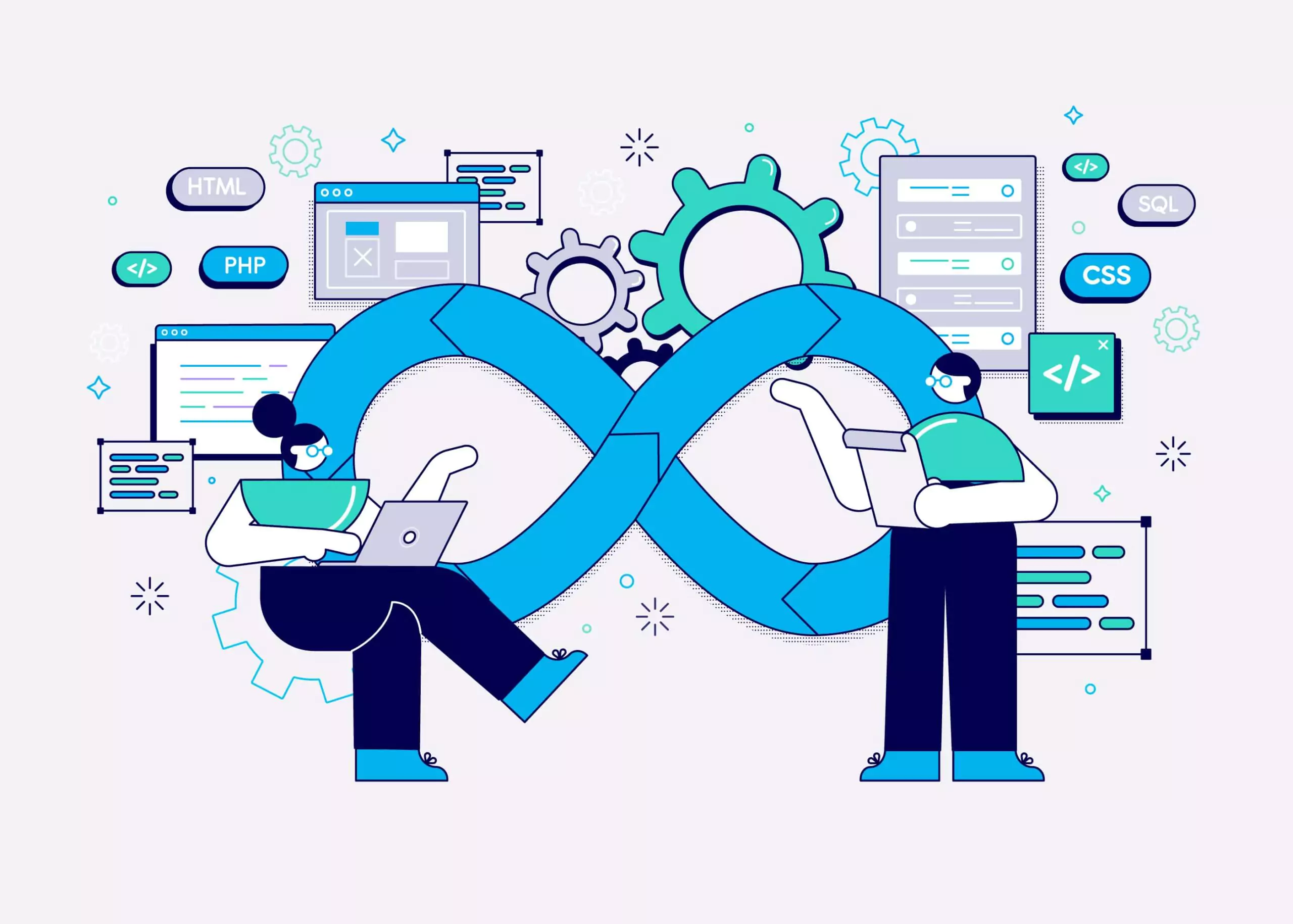
>> Read more: DataOps vs DevOps: Similarities, Differences & Use Cases
Conclusion
Although there are differences of CI/CD vs DevOps, they are still a highly compatible combination in the realm of software development. CI/CD automates tasks, and DevOps makes it easier for people to work together. Together, they make a powerful solution: faster releases, better software, and a more efficient development process with low risk. This winning combination, when implemented effectively, can empower your team to deliver high-quality software faster and more efficiently.
>>> Follow and Contact Relia Software for more information!
- development
